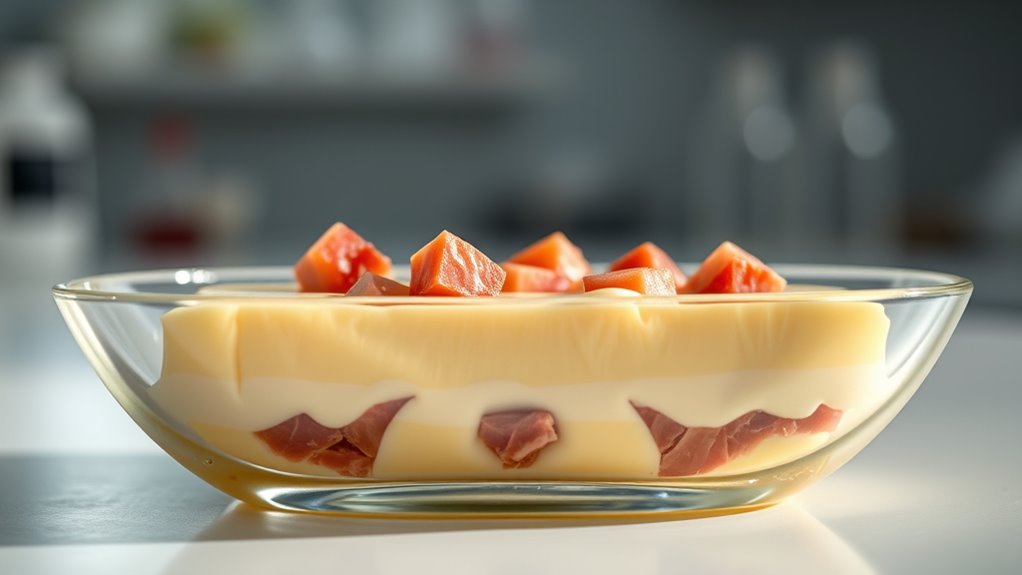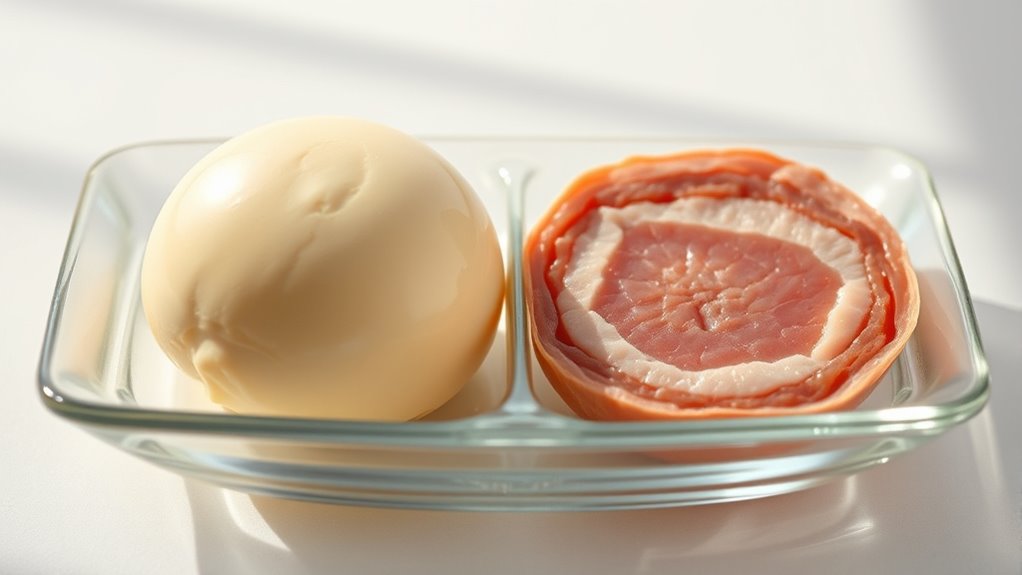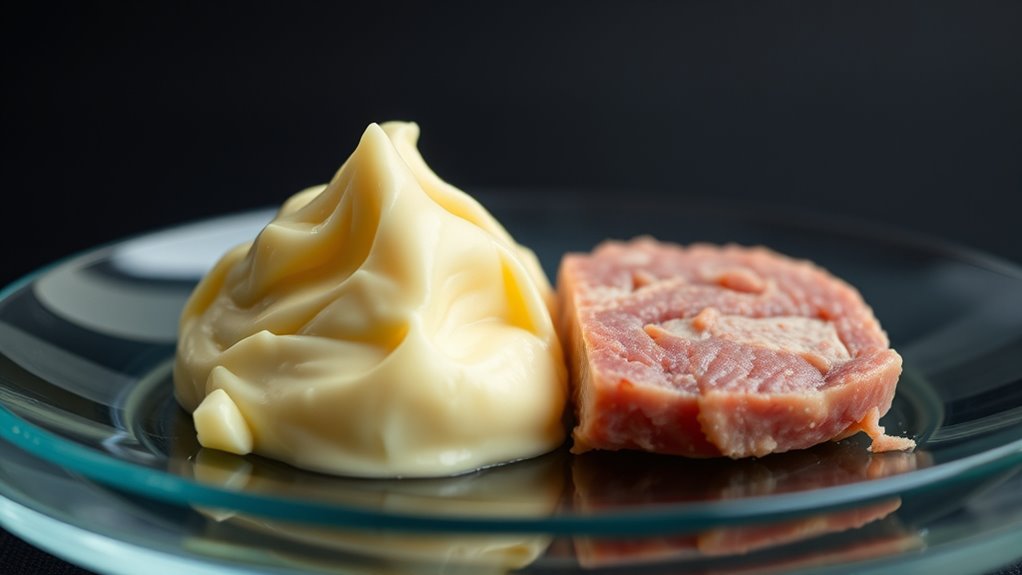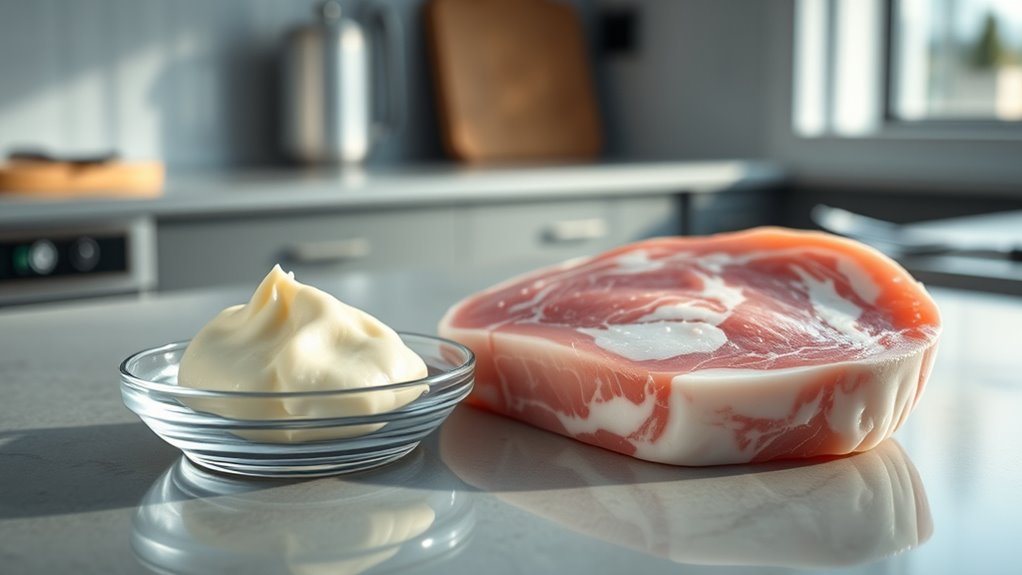Hybrid foods combining cultured butter and cultured meat are gaining momentum as sustainable, innovative options that blend cellular and traditional ingredients. Advances in genetic engineering and bioreactor technology enable scalable production while maintaining quality. These products can reduce environmental impacts like land use and emissions and appeal to consumers seeking eco-friendly, familiar flavors. However, challenges like regulatory approval and consumer acceptance remain. Explore further to see how these innovations could shape future food systems.
Key Takeaways
- Hybrid foods combining cultured butter and cultured meat aim to enhance flavor, nutritional value, and sustainability.
- Advances in genetic engineering enable seamless integration of cultured and traditional ingredients for hybrid products.
- Consumer acceptance depends on taste, transparency, and cultural factors influencing hybrid food market growth.
- Regulatory frameworks require safety testing, labeling, and certification to ensure hybrid foods meet standards.
- Culinary innovations explore fermentation and blending techniques to develop unique hybrid dishes with cultured butter and meat.
The Evolution of Cellular Agriculture: From Single-Product to Hybrid Creations

Cellular agriculture has rapidly advanced from producing single, lab-grown products to creating hybrid foods that combine cellular ingredients with traditional ingredients. Genetic engineering plays a vital role in this evolution, allowing you to modify cellular components to improve flavor profiles and nutritional content. With precise genetic tweaks, you can enhance the natural flavors of cultured ingredients, making hybrid foods more appealing and authentic. This approach not only maintains the sustainability benefits of cellular agriculture but also guarantees the final product meets consumer preferences for taste and texture. By integrating traditional ingredients with lab-grown ones, you get a new level of flavor enhancement that bridges the gap between cultivated and conventional foods. This shift marks a significant step toward more diverse and palatable hybrid food options, supported by ongoing educational efforts to inform consumers about these innovative processes.
Technological Advances Enabling Hybrid Cultured Foods

Recent technological breakthroughs have considerably advanced the development of hybrid cultured foods, making it easier to combine lab-grown ingredients with traditional components seamlessly. Genetic engineering plays a crucial role by enabling precise modifications to cell lines, improving compatibility and flavor profiles in hybrid products. These innovations also streamline the supply chain, reducing reliance on sourcing traditional ingredients and ensuring consistent quality. Advanced bioreactor designs allow for scalable production of cultured cells alongside conventional ingredients, facilitating integration at commercial levels. Additionally, automation and real-time monitoring optimize fermentation processes, lowering costs and increasing efficiency. Together, these technological advances create a more flexible framework for producing hybrid foods, paving the way for innovative combinations that meet consumer demands while maintaining sustainability and quality. Color accuracy in imaging techniques further enhances the visual appeal of these hybrid foods, ensuring they meet high-quality standards.
Potential Environmental Benefits of Merging Cultured Dairy and Meat

Merging cultured dairy and meat can substantially cut down the amount of land needed for food production, helping preserve natural habitats. It also has the potential to lower greenhouse gas emissions compared to traditional farming methods. By adopting these innovations, you can contribute to a more sustainable and eco-friendly food system. Incorporating fetal development considerations into product design can ensure safety and acceptance among consumers.
Reduced Land Use
Could reducing land use be one of the most significant environmental benefits of combining cultured dairy and meat? Absolutely. By producing hybrid foods through cultured methods, you minimize the need for large-scale farming, preserving natural habitats and biodiversity. Less land dedicated to traditional livestock means more space for forests and ecosystems. This shift also streamlines your supply chain, making it more efficient and reducing waste. Additionally, these innovations support sustainable packaging solutions, further lowering environmental impact. When land use decreases, you help conserve resources and lessen deforestation risks. Implementing cultured food technologies can further enhance these benefits by optimizing resource utilization. Overall, merging cultured dairy and meat offers a practical way to meet food demands while protecting the planet’s limited land, making it a vital step toward a more sustainable future.
Lower Greenhouse Emissions
By adopting cultured dairy and meat, you substantially reduce greenhouse gas emissions that are typically produced by traditional livestock farming. These hybrid foods create a flavor synergy that appeals to consumers while lowering the environmental footprint. Cultured methods emit fewer methane and nitrous oxide gases, major contributors to climate change. Additionally, merging cultured dairy and meat can lead to significant cost reductions in production, making eco-friendly options more accessible. This shift not only curtails land use but also minimizes the energy required for farming, processing, and transportation. As a result, greenhouse gas emissions drop noticeably. Incorporating vertical storage solutions can further optimize production facilities and reduce space-related energy consumption. Embracing these innovations supports a more sustainable food system, helping you reduce your carbon footprint without sacrificing taste or variety.
Consumer Acceptance and Market Trends for Hybrid Cultured Products

Are consumers truly ready to embrace hybrid cultured foods? It depends on how well these products align with your taste preferences and cultural acceptance. Many people are open to trying sustainable options, but acceptance varies based on familiarity and perceived authenticity. Market trends show growing interest, especially among environmentally conscious consumers seeking innovative solutions. However, acceptance hinges on transparency, clear labeling, and education about benefits. If hybrids can deliver familiar flavors and textures, you’re more likely to embrace them. Cultural acceptance also plays a role, as some regions may be more receptive to novel foods than others. Overall, consumer openness is increasing, but widespread adoption depends on how well producers address taste expectations and cultural sensitivities. Additionally, educating consumers about the safety and quality of hybrid cultured foods can significantly influence their willingness to try these innovations.
Challenges in Developing and Commercializing Hybrid Cultured Foods

Developing and commercializing hybrid cultured foods presents several significant hurdles that companies must overcome. One major challenge is conducting thorough cost analysis to ensure these products are economically viable. Hybrid foods often involve complex processes, increasing production costs and complicating pricing strategies. Scaling challenges also pose a significant barrier; moving from lab-scale experiments to commercial-scale manufacturing requires substantial investment in infrastructure and technology. Maintaining product consistency and quality during scale-up can be difficult, especially when integrating different cultured components. Regulatory hurdles further complicate commercialization, as hybrid foods must meet safety standards for multiple ingredients. Overcoming these challenges demands innovation, precise planning, and substantial resources, making the path to market more complex than traditional food development.
Nutritional Profiles and Health Implications of Hybrid Cultures

Hybrid cultures offer the potential to enhance nutritional profiles by combining beneficial compounds from different sources, but they also raise important questions about health implications. Microbial synergy in these cultures can boost nutrient density, making them richer in vitamins, minerals, and healthy fats. By leveraging the interactions between microbes, you may see increased bioavailability of nutrients and improved digestive health. Additionally, understanding macronutrient ratios is essential for optimizing health benefits when consuming hybrid foods. However, it’s crucial to consider how these combinations affect overall nutrition, as unintended imbalances could occur. While hybrid cultures can deliver more exhaustive nutrient profiles, ongoing research is needed to fully understand their health impacts. As you explore these foods, recognize that their innovative nature could lead to both nutritional benefits and new challenges for maintaining ideal health.
Regulatory Landscape and Food Safety Considerations

As hybrid foods become more common, understanding the regulatory landscape is vital. You need to be aware of labeling and certification standards to guarantee compliance, while safety testing and approval processes help protect consumers. Addressing these considerations early can help you navigate potential hurdles and build trust in your hybrid products. Additionally, staying informed about regulatory guidelines specific to hybrid foods can ensure you are aligned with current policies and standards.
Labeling and Certification Standards
Have you ever wondered how hybrid foods navigate the complex world of regulations and safety standards? It all starts with labeling standards, which guarantee consumers clearly understand what they’re buying. These standards specify how hybrid products are described, disclosed, and marketed, preventing misleading claims. Certification processes play a vital role too, verifying that products meet safety, quality, and ingredient requirements set by authorities. Manufacturers must often undergo audits and provide documentation to gain official approval, guaranteeing their products align with legal standards. Clear labeling and certification help build consumer trust and facilitate market acceptance. As hybrid foods blur traditional lines, regulators continually update guidelines to address new ingredients and production methods, ensuring safety and transparency in this evolving landscape. Additionally, understanding pimple patches and their proper application can provide insights into targeted skincare treatments, emphasizing the importance of transparent ingredient disclosure and safety standards.
Safety Testing and Approval Processes
Guiding safety testing and approval processes is crucial to guarantee hybrid foods meet regulatory standards before reaching consumers. You’ll need to verify thorough biological safety assessments, confirming that the products don’t pose health risks. This involves testing for contamination prevention, including bacteria, viruses, and other pathogens that could compromise safety. Regulatory agencies require detailed data on the manufacturing process, ingredient sourcing, and potential allergenicity. You’re also responsible for demonstrating consistent quality and safety through rigorous trials. These steps help prevent contamination issues and ensure the hybrid foods meet established food safety standards. Juice detox safety considerations highlight the importance of monitoring for potential side effects and nutrient deficiencies during product development. Guiding this approval process can be complex, but it’s essential for building consumer trust and securing market access in a highly regulated landscape.
Culinary Innovations and Recipe Development With Hybrid Cultures

Innovative chefs are pushing the boundaries of traditional cuisine by developing hybrid dishes that blend flavors, techniques, and ingredients from different cultures. They experiment with fermentation techniques to create complex, tangy profiles that complement new ingredient combinations. By exploring inventive flavor pairing, they craft dishes that surprise and delight the palate, balancing familiar and novel tastes.
Innovative chefs blend flavors and techniques to create surprising, harmonious hybrid dishes that delight the palate.
You might see:
- Fusion recipes combining Asian spices with European dairy products
- Fermentation-driven sauces enhancing meat or plant-based proteins
- Creative use of hybrid cultures to develop unique textures and flavors
These culinary innovations enable chefs to push boundaries, emphasizing harmony between diverse ingredients. As this trend grows, the focus remains on precision in flavor pairing and fermentation mastery, resulting in exciting, memorable dishes.
Ethical Perspectives and Sustainability Goals

As the popularity of hybrid foods grows, addressing ethical considerations and sustainability goals becomes increasingly important for chefs and consumers alike. You might face ethical dilemmas around balancing innovation with animal welfare and environmental impact. Some argue that hybrid foods can reduce resource use and lower greenhouse gas emissions, aligning with sustainability goals. However, cultural acceptance varies, and you may encounter resistance based on traditional food values or skepticism about hybridization. It’s essential to think through how these foods fit within diverse cultural contexts while promoting transparency about their origins and benefits. By thoughtfully navigating ethical concerns and respecting cultural perspectives, you can help foster acceptance and support sustainable practices that benefit both the planet and society.
Future Outlook: The Role of Hybrid Cultured Foods in Global Food Systems

Hybrid cultured foods are poised to play a transformative role in global food systems by offering sustainable and scalable alternatives to traditional agriculture. As these foods gain acceptance, you’ll see a shift toward greater cultural integration, blending culinary traditions with innovative production methods. Consumer perceptions will be essential; transparency about safety and environmental benefits can foster trust. To succeed, focus on:
- Embracing diverse cultural preferences to enhance acceptance
- Educating consumers on health and sustainability advantages
- Addressing misconceptions through clear, consistent communication
This approach encourages wider adoption, supporting environmental goals while respecting cultural identities. Hybrid foods have the potential to meet rising global demand efficiently, making them a critical component in shaping resilient, future-proof food systems.
Frequently Asked Questions
How Do Hybrid Cultured Foods Compare in Cost to Traditional Products?
When comparing hybrid cultured foods to traditional products, you’ll find that cost comparison varies based on production methods and market pricing. Generally, hybrid cultured foods might initially be more expensive due to advanced technology and scaling challenges. However, as production increases and technology improves, prices could drop, making hybrids more competitive. You should keep an eye on market pricing trends, as they’ll shape how affordable these innovative foods become for consumers like you.
Are There Any Allergen Concerns Unique to Hybrid Cultured Foods?
You should be aware that hybrid cultured foods can pose allergen concerns, including potential allergenic reactions that may differ from traditional products. Cross-contamination risks during production could introduce allergens into otherwise safe foods, increasing the chance of reactions. It’s important to check ingredient labels and manufacturing practices, as these factors can influence allergen presence and safety, especially since hybrid foods combine different cultured components.
What Is the Shelf Life of Hybrid Cultured Dairy-Meat Products?
You might wonder about the shelf life of hybrid cultured dairy-meat products. Storage stability varies depending on ingredients and processing methods, but generally, these products need refrigeration to maintain freshness. Guaranteeing microbial safety is vital; proper packaging and handling can extend shelf life and prevent spoilage. Typically, you can expect a shelf life of several weeks if stored correctly, but always check specific guidelines for each product to assure safety and quality.
How Might Hybrid Cultured Foods Influence Global Food Security?
Hybrid cultured foods could drastically improve global food security by boosting sustainability benefits and reducing resource use. You might see these foods gaining cultural acceptance as they offer familiar flavors with lower environmental impacts. By producing more efficiently and using fewer land and water resources, hybrids can help feed a growing population, especially in areas facing food scarcity. This innovation supports a more resilient and sustainable food system worldwide.
Can Hybrid Cultured Foods Be Customized for Specific Dietary Needs?
You can definitely customize hybrid cultured foods to meet specific dietary needs. With advances in personalized nutrition, these foods can be tailored to accommodate dietary restrictions like allergies or intolerances, ensuring you get the nutrients you need without unwanted ingredients. This customization makes hybrid cultured foods a versatile solution, helping you maintain a balanced diet while enjoying the benefits of innovative, sustainable food options.
Conclusion
As hybrid cultured foods herald a harmonious harmony of health, habitat, and hope, you can embrace this innovative intersection of imagination and impact. By blending bold biotechnology with sustainable sensibilities, you’re stepping into a future where food fosters fitness, forests flourish, and flavors fulfill. This pioneering path promises progress, passion, and preservation—paving the way for a more mindful, manageable, and mesmerizing meal revolution. Get ready to partake in this promising, pioneering protein partnership.










